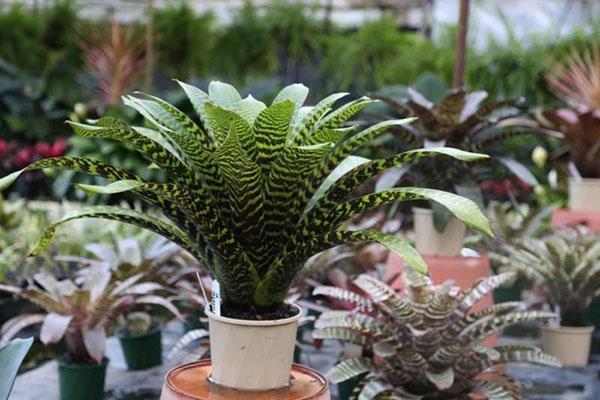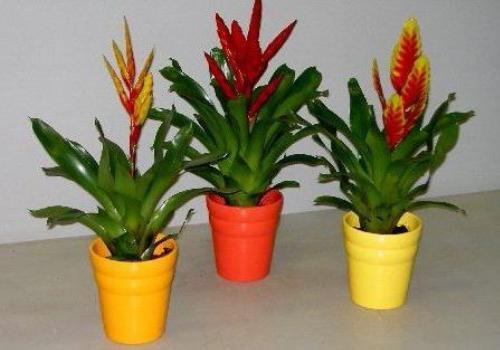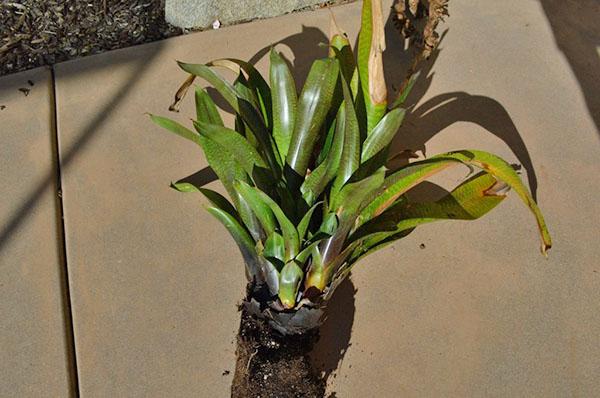Different ways of breeding Vriezia
 The appearance of a new plant on the windowsill is always a memorable and very pleasant event! If the grower fell in love with Vriezia, the methods of propagation of this plant will help not only to regularly replenish the collection, but also simply not to lose the bright indoor culture.
The appearance of a new plant on the windowsill is always a memorable and very pleasant event! If the grower fell in love with Vriezia, the methods of propagation of this plant will help not only to regularly replenish the collection, but also simply not to lose the bright indoor culture.
Vriezia is a plant of the bromeliad family, to which the well-known a pineapple, the bromeliad itself and the beloved guzmania by flower growers. An indoor flower is easily recognizable by a powerful rosette of elongated leaves that grow as they grow older. When Vriezia blooms, releasing a peduncle with a spike-shaped inflorescence, her life begins to decline. Without additional points of growth, the rosette dies, so the question arises of the renewal of the flower.

Reproduction of Vriezia by shoots is not the only possible way. Enthusiasts of this culture know that with a certain skill and knowledge, a flower can be propagated using seeds.
Reproduction of vriezia by shoots
 Although at the end of flowering, the life of the vriezia naturally ends, the plant itself takes care of the continuation of its kind. Fast growing offspring appear at the base of the rosette.
Although at the end of flowering, the life of the vriezia naturally ends, the plant itself takes care of the continuation of its kind. Fast growing offspring appear at the base of the rosette.
For 40–60 days, daughter plants form quite viable rosettes. It is convenient to separate them during transplantation, when the entire root system is outside the pot, and separation can be carried out with minimal losses.
Young rosettes may have roots. But sometimes it is not possible to save them, or the outlet is still so small that it did not have time to acquire its own food organs. Do not despair and throw away precious planting material.
 After treatment with a growth stimulant and falling into favorable conditions, young vriezia is restored and forms a root system.
After treatment with a growth stimulant and falling into favorable conditions, young vriezia is restored and forms a root system.
As a substrate for propagation of vriezia by shoots, a mixture is used based on:
- washed river sand;
- peat;
- leafy land.
To structure the soil, crushed bark and charcoal are added to it. The last component will protect young plants from rot and reproduction of bacterial flora.
Planting is carried out shallow, making sure that the soil does not fall into the core of the outlet. The pots are placed in a room greenhouse, where the temperature is maintained at 25-27 ° C.
 Care after transplanting is reduced to watering with soft water and maintaining increased, but not excessive air humidity. The formation of abundant condensation, which threatens the multiplication of mold and the decay of new vries, must not be allowed. Therefore, the greenhouse is regularly ventilated, and overhanging drops are removed with a soft cloth. The appearance of fresh leaves is a signal that the plant has taken root, and it can be transferred to the windowsill to its adult counterparts.
Care after transplanting is reduced to watering with soft water and maintaining increased, but not excessive air humidity. The formation of abundant condensation, which threatens the multiplication of mold and the decay of new vries, must not be allowed. Therefore, the greenhouse is regularly ventilated, and overhanging drops are removed with a soft cloth. The appearance of fresh leaves is a signal that the plant has taken root, and it can be transferred to the windowsill to its adult counterparts.
The advantage of this method is that propagation of Vrieseia by shoots allows you to get exact copies of the parent plant, preserving the appearance of both decorative leaves and catchy spike-shaped inflorescences.
Reproduction of vriezia by seeds
 This method of breeding vriezia is more laborious than the previous one, but it is he who helps to get new hybrids and will interest real fans of indoor culture.
This method of breeding vriezia is more laborious than the previous one, but it is he who helps to get new hybrids and will interest real fans of indoor culture.
Vriezia flowers are short-lived, but if they are naturally or artificially pollinated, seeds are formed that can give life to new plants. They are ready for planting when the seed pods open.
 For sowing, use a loose light mixture based on:
For sowing, use a loose light mixture based on:
- turf and leafy land, taken in equal shares;
- peat cleared of coarse inclusions in half of the soil;
- a small amount of river sand to loosen the substrate;
- crushed, pre-steamed bark;
- sphagnum.
 If it is not possible to make the soil yourself, take a ready-made mixture for bromeliads or orchids. The last substrate is too coarse, so it is crushed with this method of reproduction of Vriese. The seeds are spread over the surface and moistened abundantly. In conditions of high humidity and at a temperature of about 25 ° C, seedlings appear in 2-3 weeks.
If it is not possible to make the soil yourself, take a ready-made mixture for bromeliads or orchids. The last substrate is too coarse, so it is crushed with this method of reproduction of Vriese. The seeds are spread over the surface and moistened abundantly. In conditions of high humidity and at a temperature of about 25 ° C, seedlings appear in 2-3 weeks.
Large seeds are laid out on a fine-mesh plastic mesh stretched over a shallow container. Covering such a container with a lid, you can get an impromptu greenhouse for germinating vriezia.
Tiny sockets can be dived after 2 months, and at the age of six months, Vriezii are transplanted to a permanent place of residence.
 Transplanting tiny outlets requires special attention. It is important not to deepen the core, otherwise the growth point quickly decays, dooming the entire plant to death. Until the seedlings are transferred to permanent pots, it is better to keep them in a greenhouse with high humidity and constant temperature. Further care for vriezia after transplantation does not differ from the usual one, which consists in watering and infrequent feeding with liquid formulations for bromeliads.
Transplanting tiny outlets requires special attention. It is important not to deepen the core, otherwise the growth point quickly decays, dooming the entire plant to death. Until the seedlings are transferred to permanent pots, it is better to keep them in a greenhouse with high humidity and constant temperature. Further care for vriezia after transplantation does not differ from the usual one, which consists in watering and infrequent feeding with liquid formulations for bromeliads.